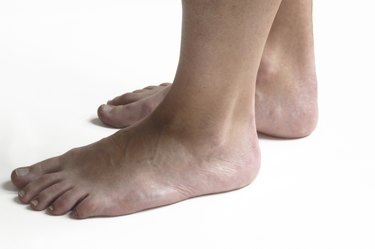
Your Achilles tendon anchors your calf muscles to the back of your heel bone, and its movement is what allows you to point your toes and otherwise move your foot for walking and running. If your tendon shrinks it can cause ongoing pain just above your heel whenever you put weight on your foot. This is common among women who frequently wear shoes with heels higher than 2 inches. The tendon shrinks in length when the foot is repeatedly in tiptoe position, and then when the wearer tries to go barefoot or wear flats, it can't accommodate that extra stretch.
Basic Seated Stretch
Video of the Day
Step 1
Sit in a chair with your leg extended and your heel on the floor. Your foot should be at about a 90-degree angle with your leg, if possible.
Video of the Day
Step 2
Reach down and pull your big toe up toward you until you feel the pull. Never pull to the point of pain.
Step 3
Hold the stretch for about 20 seconds. Do a total of five of these stretches in each of five sessions every day.
Standing Wall Stretch
Step 1
Stand facing a wall with your body arm's-length away and your palms planted against the wall.
Step 2
Plant your affected leg back 6 inches or so from the other leg, which should remain arm's-length from the wall. Press the heel of the back leg to the floor and keep that knee straight.
Step 3
Bend your elbows and your front knee until you feel the pull in the calf in your back leg.
Step 4
Stay in this position for 30 to 60 seconds, then switch legs if necessary.
Stair Stretch
Step 1
Stand with the front half of your foot on a stair, with your heels hanging over the edge. If you don't have stairs in your house, you can stand on a large phone book or even a board such as a two-by-four. Hold on to the railing or a nearby piece of furniture to keep from slipping off the edge.
Step 2
Dip the heel of your affected leg down below the edge of the stair. Take it down slowly until you feel the pull in your calf.
Step 3
Stay in this position for about 20 seconds. Do five reps of this stretch, working up to five sets per day.
Warning
Always stretch gently, as pushing too hard on an already-tight tendon can cause it to snap. The final exercise, the Stair Stretch, is a more advanced stretch. Work on the first two stretches first until your tendon is more flexible. Check with your doctor to make sure it is safe for you to do the Stair Stretch.
Is this an emergency? If you are experiencing serious medical symptoms, please see the National Library of Medicine’s list of signs you need emergency medical attention or call 911.